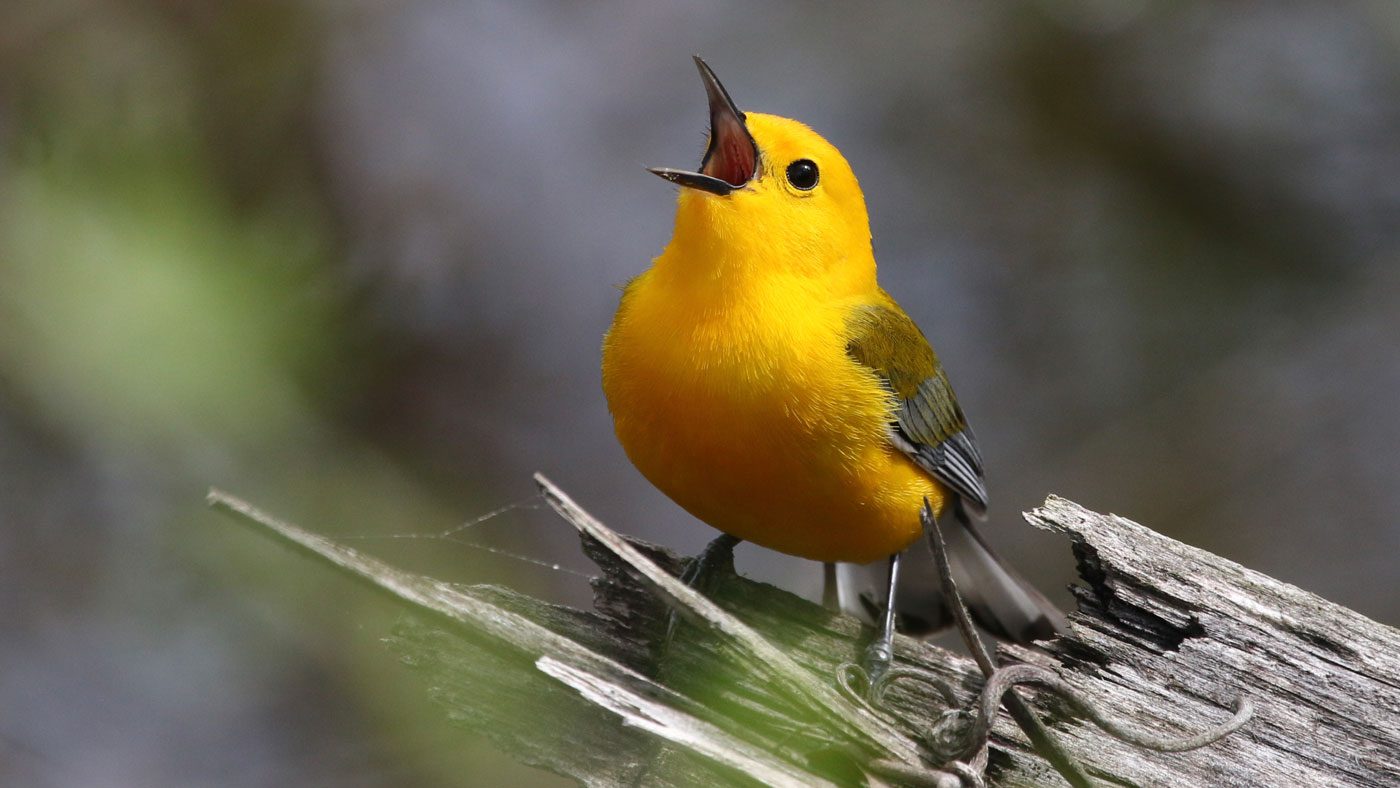When a bird sings it’s telling you what it is and where it is. Learn bird calls and open a new window on your birding.
Originally published April 2009; last updated May 2024.
You can only see straight ahead, but you can hear in all directions at once. Learning bird songs is a great way to identify birds hidden by dense foliage, faraway birds, birds at night, and birds that look identical to each other. In fact, when biologists count birds in the field, they find the great majority of species by sound rather than sight.
Learning calls and songs helps in two ways: First, you can do a quick survey of what’s around before you even step foot on a trail. And second, when you hear something you don’t recognize, you know where to put your attention.
Owls and nightjars are obvious examples of the usefulness of hearing in identification. Another great example are the dozen or so confusing flycatchers in the Empidonax group. These birds look so similar they’re sometimes impossible to identify even in the hand. But all that uncertainty vanishes as soon as the bird starts to sing.
Five Tips for Beginners
1. Use Your Eyes to Help Your Ears
When you see a bird singing, the connection between bird and song tends to stick in your mind.
2. Learn from Others
It’s hard to learn bird songs from scratch—and much easier if a fellow birdwatcher points out new sounds to you. Check for a nearby bird club or nature reserve and join a field trip.
3. Use Sound ID in Your Merlin App
Record the birds singing around you and let Merlin help you ID who’s singing. Working in real time while you’re out birding, Merlin can identify more than 1,300 species of birds in the Americas, Europe, and India. It even highlights birds’ names as they sing and allows you to go back to a particular song after you’ve finished recording. More about how to use Merlin Sound ID.
4. Listen to recordings
Start by listening to recordings of birds you’re used to seeing. Play them often to help the sounds stick in your mind. Our All About Birds guide has sounds for more than 650 North American species, with many thousands more available at the Cornell Lab of Ornithology’s Macaulay Library. You can also use our free Merlin Bird ID app to listen to songs and calls of birds from all over the world.
5. Mnemonics Can Help
Some songs almost sound like words – who can mistake the Barred Owl’s “Who cooks for you all?” Mnemonics can make a song a snap to remember.
Try It: Listen for Mnemonics
How to Listen to a Song
When you first listen to a dawn chorus in full swing, the sheer onslaught of bird song can be overwhelming. How does anyone start to pick apart the chirps, whistles, and trills that are echoing out of the woods? The answer, of course, is to concentrate on one bird at a time—and that approach holds true when you’re trying to learn individual songs, too.
Don’t try to memorize each entire song you hear. Instead, focus on one quality of the sound at a time. Many birds have a characteristic rhythm, pitch, or tone to their song. Once you zero in on it, you’ll have a better sense of the bird’s identity. When you combine these characters, you can narrow things down even further. Here are a few examples:
1. Rhythm
Get used to a bird’s characteristic tempo. Marsh Wrens sing in a hurry, while White-throated Sparrows are much more leisurely. Try it:
2. Pitch
Most birds sing in a characteristic range, with smaller birds (like the Cedar Waxwing) typically having higher voices and larger birds (like the Common Raven) usually having deeper voices. Many bird songs change pitch, as in the Prairie Warbler’s rising, buzzy song or the Canyon Wren’s sweet descending whistles. Some birds are distinctive for having steady voices, like the Chipping Sparrow’s trill.
Try It: Compare Song Pitches
3. Repetition
Some birds characteristically repeat syllables or phrases before moving on to a new sound. Northern Mockingbirds do this many times in a row. Though Brown Thrashers sound similar, they typically repeat only twice before changing to a new syllable. Try it:
4. Tone
The tone of a bird’s song is sometimes hard to describe, but it can be very distinctive. To begin with, pay attention to whether a bird’s voice is a clear whistle, harsh or scratchy, liquid and flutelike, or a clear trill. If you can remember the quality of a bird’s voice, it can give you a clue to the bird’s identity even if the bird doesn’t sing the same notes every time. Here are a few examples:
Try It: Compare Tones
Whistles
Harsh Tones
Liquid or Flutelike Tones
Trills
Spectrograms
Ever wish you could “see” a sound so you could study its details? Spectrograms allow you to do just that. They’re simple graphs that show you the frequency, or pitch, of a sound, its loudness, and how these change over the course of the sound. With a little practice, they can reveal much more about a sound than your ears could detect on their own.
With a little practice, you can read the sounds almost like you might read a sheet of music. The higher the marks on the graph, the higher the pitch of the sound. The brightness of the marks indicate how loud the sound is at that moment. As you move from left to right on the graph you move farther along in the bird’s song.
Next, click over to Bird Song Hero to try out your new skills with other bird songs. It’s a great way to start visualizing what you’re hearing—which will help you learn who’s singing.

